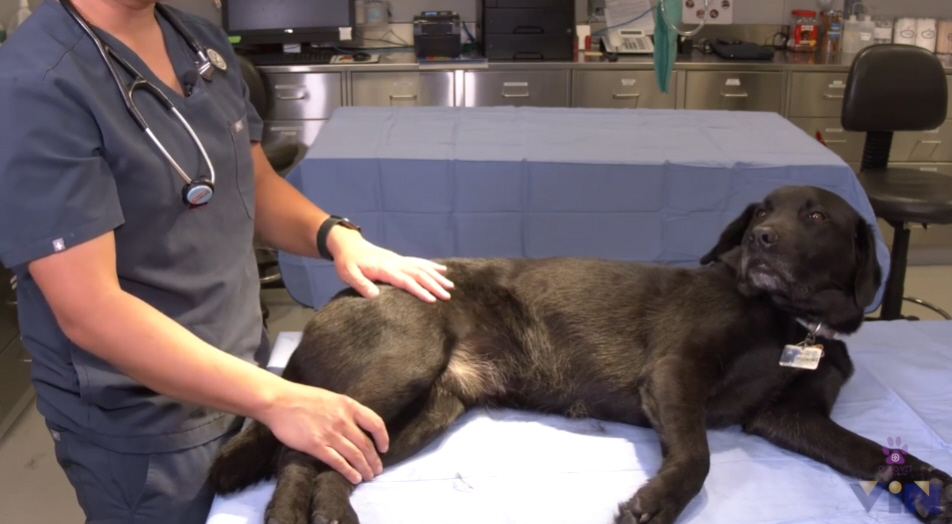Black dog waits on exam table

A complete urinalysis (UA) analyzes your pet’s urine, as part of a complete health assessment. It is often done at the same time as blood tests ordered by your veterinarian. A complete UA consists of:
- Initial inspection of the urine and its appearance (color, clarity, etc)
- Assessment of concentrating ability
- Dipstick/chemical analysis
- Sediment examination
A refractometer is a specialized tool used to determine the concentration of substances within a liquid. It measures the urine’s specific gravity (USG), a rough estimate of the urine’s concentration, which indicates your pet’s hydration status and kidney function. However, the USG can be affected by other diseases, medications, and diets, so it is important to look at the USG while considering your pet’s clinical signs and other diagnostic tests. If this test is abnormally low, your veterinarian may want multiple urine samples over time to judge the ability of your pet’s kidneys to concentrate urine.
A dipstick analysis is done to identify what is present in the urine, such as protein, blood, glucose (sugar from the blood), or ketones (a substance created in the body during certain illnesses). The dipstick test also determines urine pH. The chemical pads on the stick change color depending on what substances may be in the urine.
A sediment analysis involves looking at urine under a microscope. The urine is concentrated using a centrifuge that spins the urine at high speeds to separate out solids such as cells or crystals. That concentrated sample is put on a glass slide and examined. Stains may be used. Under a microscope, your veterinarian can see if there are bacteria, crystals, cells, or other solid material in the urine.
How is Urine Collected?
Selecting the method for collecting urine depends on the illness your veterinarian suspects and your pet's willingness to cooperate.
The free catch method is the easiest and can be done in the clinic or at home. This involves catching the urine in a cup or other clean, ideally sterile, container. For best test results, try to collect the sample the first time your pet pees in the morning. Bring the sample to the clinic as soon as possible. Until then, place the urine in the refrigerator for up to a few hours in a syringe or a lid-covered container.
In the clinic, urine is often collected with a cystocentesis. Your pet is held while a small needle is placed through the skin into the bladder. The bladder is found by feeling the abdomen or using an ultrasound to see the bladder. Most pets tolerate this procedure quite well, and it is usually used on cats. This method is often the best way to collect a sterile sample to determine if an infection is present.
When sick, your pet may pee frequently in small amounts, including during examinations, making it hard to collect a sample. The urine can be collected from the floor or table. This is not the best sample, as it is contaminated, but if urine is hard to collect, it may help provide crucial information.
A sterile urinary catheter can be used to collect a direct sample. Your pet may need to be sedated or given additional medications to allow the catheter to be placed. This method can be uncomfortable, but with appropriate care, complications are uncommon.
The urine can be sent to a laboratory or analyzed within the clinic. Typically, an analysis done at the clinic can give faster results, and there may be fewer artifacts from the urine sample sitting for a prolonged time before testing. However, larger laboratories can do additional tests that are not possible at most veterinary clinics.
Why Does My Veterinarian Want a Urinalysis?
Urine may be collected during routine screenings and other bloodwork, especially in older animals. A urinalysis can help identify early kidney disease, which is common in older animals, and other diseases.
Additionally, a urinalysis is often done if your pet shows certain signs, such as frequent urination, not urinating, painful urination, excessive drinking, or having accidents in the house. This is often one of the first tests done for cats who start eliminating outside the litterbox.
In some cases, your veterinarian may want a urinalysis to diagnose other suspected diseases. For instance, urine can be screened for glucose when diagnosing diabetes mellitus.
What Happens After a Urinalysis?
Your pet’s urinalysis results may indicate a need for more tests. At a larger laboratory, your veterinarian may be able to add these tests to the current urine sample, or they may need additional urine or blood samples from your pet. Common tests added to the UA include a urine culture to determine which bacteria are present or a urine protein: creatinine (UPC) ratio that helps quantify the amount of abnormal protein in the urine.
In other cases, the urinalysis results may help your veterinarian diagnose what’s causing your pet’s signs. They may be able to start treatment or select other necessary diagnostic tests.